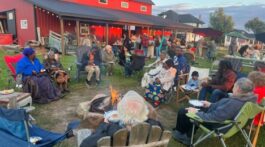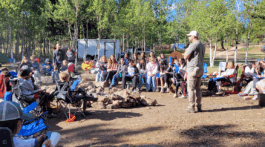If you’ve gotten past the title, you know there are problems. We’ll get to those. However, in my travels around the Mid-America Union and beyond I find quite a bit of confusion over the basic structure of the church, so perhaps now is a good time for clarification.
But first some history. Following the disappointment that occurred to early Advent believers when Jesus did not return on October 22, 1844, that very small group went back to their Bibles and intensely studied again and again—in parlors, barns and kitchens. Those believers hammered out much of what we as Seventh-day Adventists believe today: the Sabbath, the Second Coming, the essential unity of the body (soul is not separate and eternal), the Sanctuary, the Spirit of Prophecy and more.
They also agreed they did not want an organization. Most of them had been cut-off from fellowship in their churches before 1844 and believed that an organization was not only unnecessary but detrimental to the cause.
That feeling persisted until it became clear that the fledgling movement was at the mercy of those who owned the land, buildings, tents and other tangible assets. Also, with the Civil War raging, Adventist draftees who wanted to serve in non-combatant roles needed a recognized organization to speak for them. Furthermore, the question persisted as to who had the authority to identify preachers as able to represent the movement.
How did structuring occur?
In 1861 the Michigan Conference was organized, followed by a few other states, culminating in the 1863 establishment of the General Conference in Battle Creek, Michigan. There was some dissension, but the church moved forward. Out of this grew the Sabbath school society, the “tract society” and many other forerunners of the various departments of the church we know today. By the middle 1870s the movement sent its first foreign missionaries and the resultant growth has been remarkable.
Guided by the counsel of Ellen White, in 1901 and 1903 the church reorganized itself, diversifying authority across several levels rather than having consolidated power in the hands of a small group of men in Battle Creek. Union conferences and divisions were formed and, with minor adjustments, by 1920 the organizational structure we have today was in place.
The local church joins with other area churches to form a local conference for a given territory (often reflecting state or national boundaries). Those conferences band together to form a union conference. The General Conference is composed of all the union conferences in the world. And the General Conference has chosen to express itself in the 13 divisions, each of which is not a constituent group but rather a segment of the GC. Divisions normally reflect large geographic areas and provide cohesion among the unions.
What should I know for 2015?
In July 2015 each of the Unions will send delegates to the world church’s General Conference Session in San Antonio, Texas to transact the business of the organization. There will be about 2,000 voting delegates. Observers and guests will swell that number to more than 50,000 on Sabbath. Leaders will be nominated and elected through a complex representative process. The constitution and the by-laws may be adjusted to reflect current legal and practical exigencies. The Church Manual will be examined, as will the Statement of 28 Fundamental Beliefs.
Attendees will be treated to extensive and often thrilling reports of the progress of the Adventist World Church. And they will be challenged with news of the cost paid—even in blood— by those willing to go where the gospel is unknown and unwelcome.
A question that is part of numerous church conversations as we anticipate this GC Session is the ordination of women to the gospel ministry. It has been on the minds of many since the early 1880s but more acutely during the last 40 years. Five years ago the General Conference convened a special Theology of Ordination Study Committee to try to reach consensus before next July. Over the last two years that committee of 106 members has met three times for multiple days each time in its quest for a workable conclusion.
TOSC, as it is known, reported to the General Conference Executive Committee at Annual Council in October. Unable to reach the bar of 90 percent agreement established by General Conference leadership, they reported three different positions on the matter. The first one, on the basis of Scripture, rejects women’s ordination completely, including the now long established practice of ordaining women as local church elders. The second position, on the basis of Scripture, supports women’s ordination to be decided on a division-by-division basis. The third position states that the Bible is not clear on the matter, in which case the church has the authority to decide and should do so on a division-by-division basis.* Roughly two-thirds of TOSC members favored positions two or three.
How does this affect my local church?
The suggested changes to the Church Manual include matters of church discipline that may have a local impact, depending on what surfaces in your church. Proposed changes in the 28 Fundamental Beliefs are largely editorial. What really matters is how we use our beliefs. Do we share them as a way to reveal the wonderful character of our God, or do we use them as a filter by which to exclude those whose word choices may be different from our own? As for the ordination of women, the option to allow divisions to make that determination for their territory is permissive in nature rather than prescriptive. Just because a division votes to allow it does not mandate that a union grant ordination; nor does it mandate that a local conference hire women and ordain them. The TOSC itself has clearly stated that all members of that committee, no matter their position, are solid Seventh-day Adventists.
So what’s wrong with this article’s title?
First off, it isn’t your church, nor is it mine. Jesus said, “I will build my church and the gates of hell will not prevail against it” (Matt.16:18). The church is His. So lest we get all worked up about the issues and start flinging invectives around, we need to remember that the Lord Himself has preserved His church down through the ages without any help from us. And He is still in charge.
Therefore, it becomes critically important not that we get God on our side, but that we submit ourselves to His side. That means having a humble, teachable and Christ-like attitude. In addition, it is essential to realize that the truth about the church changes over time. James White and Joseph Bates would not recognize the Adventist church of today.
Organizational structure is a tool to promote the mission the Lord has given us, which happens in local churches and communities. When that functionality loses effectiveness, then we must be prepared to carefully and prayerfully make the changes that will propel His movement forward.
Please join the Pray One Million initiative sponsored by the North American Division and be in much prayer as we work through this pivotal year in the mission of God’s church.
*This summation of the positions is my own terminology.










